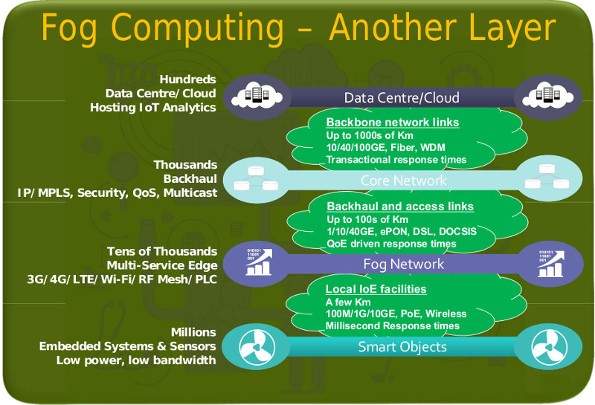As if the Internet of Things (IoT) was not complicated enough, the Marketing team at Cisco introduced its Fog Computingvision in January 2014, also known as Edge Computing for other more purist vendors.
Given Cisco′s frantic activity in their Internet of Everything (IoE) marketing campaigns, it is not surprising that many bloggers have abused of shocking headlines around this subject taking advantage of the Hype of the IoT.
I hope this post help you better understand what is the role of Fog Computing in the IoT Reference Model and how companies are using IoT Intelligent gateways in the Fog to connect the “Things” to the Cloud through some applications areas and examples of Fog Computing.
The problem with the cloud
As the Internet of Things proliferates, businesses face a growing need to analyze data from sources at the edge of a network, whether mobile phones, gateways, or IoT sensors. Cloud computing has a disadvantage: It can’t process data quickly enough for modern business applications.
The IoT owes its explosive growth to the connection of physical things and operation technologies (OT) to analytics and machine learning applications, which can help glean insights from device-generated data and enable devices to make “smart” decisions without human intervention. Currently, such resources are mostly being provided by cloud service providers, where the computation and storage capacity exists.
However, despite its power, the cloud model is not applicable to environments where operations are time-critical or internet connectivity is poor. This is especially true in scenarios such as telemedicine and patient care, where milliseconds can have fatal consequences. The same can be said about vehicle to vehicle communications, where the prevention of collisions and accidents can’t afford the latency caused by the roundtrip to the cloud server.
“The cloud paradigm is like having your brain command your limbs from miles away — it won’t help you where you need quick reflexes.”
Moreover, having every device connected to the cloud and sending raw data over the internet can have privacy, security and legal implications, especially when dealing with sensitive data that is subject to separate regulations in different countries.
IoT nodes are closer to the action, but for the moment, they do not have the computing and storage resources to perform analytics and machine learning tasks. Cloud servers, on the other hand, have the horsepower, but are too far away to process data and respond in time.
The fog layer is the perfect junction where there are enough compute, storage and networking resources to mimic cloud capabilities at the edge and support the local ingestion of data and the quick turnaround of results.
The variety of IoT systems and the need for flexible solutions that respond to real-time events quickly make Fog Computing a compelling option.
The Fog Computing, Oh my good another layer in IoT!
A study by IDC estimates that by 2020, 10 percent of the world’s data will be produced by edge devices. This will further drive the need for more efficient fog computing solutions that provide low latency and holistic intelligence simultaneously.
“Computing at the edge of the network is, of course, not new — we’ve been doing it for years to solve the same issue with other kinds of computing.”
The Fog Computing or Edge Computing is a paradigm championed by some of the biggest IoT technology players, including Cisco, IBM, and Dell and represents a shift in architecture in which intelligence is pushed from the cloud to the edge, localizing certain kinds of analysis and decision-making.
Fog Computing enables quicker response times, unencumbered by network latency, as well as reduced traffic, selectively relaying the appropriate data to the cloud.
The concept of Fog Computing attempts to transcend some of these physical limitations. With Fog Computing processing happens on nodes physically closer to where the data is originally collected instead of sending vast amounts of IoT data to the cloud.
[color=rgb(255, 255, 255) !important]

Photo Source: http://electronicdesign.com/site-files/electronicdesign.com/files/uploads/2014/06/113191_fig4sm-cisco-fog-computing.jpg
The OpenFog Consortium
The OpenFog Consortium, was founded on the premise based on open architectures and standards that are essential for the success of a ubiquitous Fog Computing ecosystem.
The collaboration among tech giants such as ARM, Cisco, Dell, GE, Intel, Microsoft and Schneider Electric defining an Open, Interoperable Fog Computing Architecture is without any doubt good news for a vibrant supplier ecosystem.
The OpenFog Reference Architecture is an architectural evolution from traditional closed systems and the burgeoning cloud-only models to an approach that emphasizes computation nearest the edge of the network when dictated by business concerns or critical application the functional requirements of the system.
The OpenFog Reference Architecture consists of putting micro data centers or even small, purpose-built high-performance data analytics machines in remote offices and locations in order to gain real-time insights from the data collected, or to promote data thinning at the edge, by dramatically reducing the amount of data that needs to be transmitted to a central data center. Without having to move unnecessary data to a central data center, analytics at the edge can simplify and drastically speed analysis while also cutting costs.





 雷达卡
雷达卡




 提升卡
提升卡 置顶卡
置顶卡 沉默卡
沉默卡 变色卡
变色卡 抢沙发
抢沙发 千斤顶
千斤顶 显身卡
显身卡





 京公网安备 11010802022788号
京公网安备 11010802022788号







